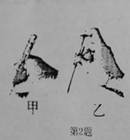阅读理解。
On a rainy day, you will see many streams of muddy (多泥的) water running down the slopes (山坡) of
a hill. The water is muddy because it washes away soil from the hill slopes.
Sometimes soil is blown away by strong winds. When the soil is carried away by water or wind, we say
that the land is eroded (侵蚀). This is known as soil erosion.
Plants cannot grow on eroded land. There is not enough soil on eroded land to give them the things they
need. Plants need water and salts from the soil.
We can do a number of things to stop soil erosion. This is called soil conservation (保护).
One way of soil conservation on flat, open ground is to grow small plants such as grasses. Their roots
hold the soil tightly together. Another way is to plant trees around an open field. Thus soil erosion by strong
winds cannot take place. Rows of trees act as a very big wall.
Soil erosion on slopes can be stopped by cutting "steps" called terraces (梯田). Water carrying soil cannot
run straight down the slope now. It has to run down the terraces. This slows down the flow of the water.
Most of the soil in the water is left behind on the terraces.
There are some other ways of soil conservation.
1. On a rainy day the water running down the slopes of a hill is muddy because _____. [ ]
A. there is no terrace on the slopes
B. there is no small plant on the slopes
C. it washes away soil from the slopes
D. there is too much soil on the slopes
2. Plants cannot grow on eroded land because _____. [ ]
A. there is a lot of sand
B. there is not enough water and salts
C. there is no water
D. the land is too hard
3. One way of soil conservation on flat, open ground is _____. [ ]
A. to grow small plants such as grasses
B. to plant trees around an open field
C. to add fertilizer to the soil
D. A and B
4. From the passage we learn that there are _____ ways to reserve soil.[ ]
A. only three
B. two
C. more than three
D. six

